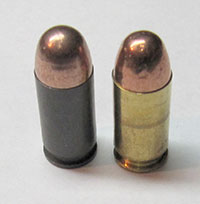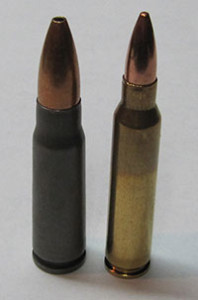
In researching the operation of a blow back designed pistol I learned that after ignition the case expands against the chamber walls. This causes the case to tightly grip the chamber and forms a gas seal. Case expansion under high pressure holds the cartridge in the chamber until after the bullet leaves the muzzle. Once the bullet exits the barrel then pressure drops, the case shrinks releasing its grip on the chamber walls. At this point the chamber pressure is still high enough to push the case rearward against the bolt to cycle the action, extracting the empty case, stripping the next round from the magazine stack, and load the new round in the chamber. Brass and aluminum case ammunition expand and contract sufficiently to provide satisfactory operation. Steel case ammo requires more pressure to expand enough to seal the chamber and then doesn’t contract as much as the brass and aluminum cases.

I have shot thousands of rounds of 9mm, 45ACP, and 7.62×39 steel cased ammo through my guns and didn’t understand why that is not a good idea. The steel requires more pressure to conform the case to the chamber walls, doesn’t seal as well, and is also coated with varnish or plastic to inhibit rust. This coating, when subjected to high combustion chamber temps, melts and flows onto the chamber walls which can eventually cause failure to extract.
This is especially noticeable if steel case ammo is used in an AR15. The straight walls of the 5.56×45 and 223 case can get stuck in the chamber from the melted plastic and varnish coating the chamber walls coupled with the fact that steel case does not contract as much as a brass case. That is why the Russian 7.62×39 case is tapered so it will provide better extraction reliability when manufactured with a steel case.
Weapons designed to use steel case ammunition, like the AK47, usually have a more violent extraction method than typical American made weapons.
I stopped using steel cased ammo when I took up reloading. Although at the time I didn’t fully understand all the reasons why it is not a good idea to use it in my guns, especially the calibers having a straight walled case. NOTE: Reloading steel case ammo is not recommended.
Another point to keep in mind is that almost all of it is manufactured in Eastern Europe and Russia. In that part of the world the Berdan primer is used. Berdan primers are harder and require more firing pin force. It is not uncommon for American made weapons to have failure to fire issues with Berdan primers.
It is interesting to note that the Berdan primer is an American invention and is commonly used in European and Eastern made ammo. The Boxer primer is a European invention that is commonly used in US made ammo.